MKTG 310: Smart Helmet - A Comprehensive Marketing Strategy Report
VerifiedAdded on 2023/05/29
|6
|1629
|151
Report
AI Summary
This report outlines a marketing strategy for a new product called the Smart Helmet, designed for bikers. It details the product's features, including GPS, LED lights, and walkie-talkie functionality. The report focuses on demographic segmentation, targeting individuals aged 16-40 from the upper-middle class with a keen interest in biking. The pricing strategy employs price skimming, setting an initial price of $250. The report also discusses the 4Ps (Product, Price, Place, Promotion) at each stage of the Product Life Cycle (PLC), from introduction to decline, providing a comprehensive marketing plan for the Smart Helmet. Desklib provides a platform for students to access similar documents and study tools.
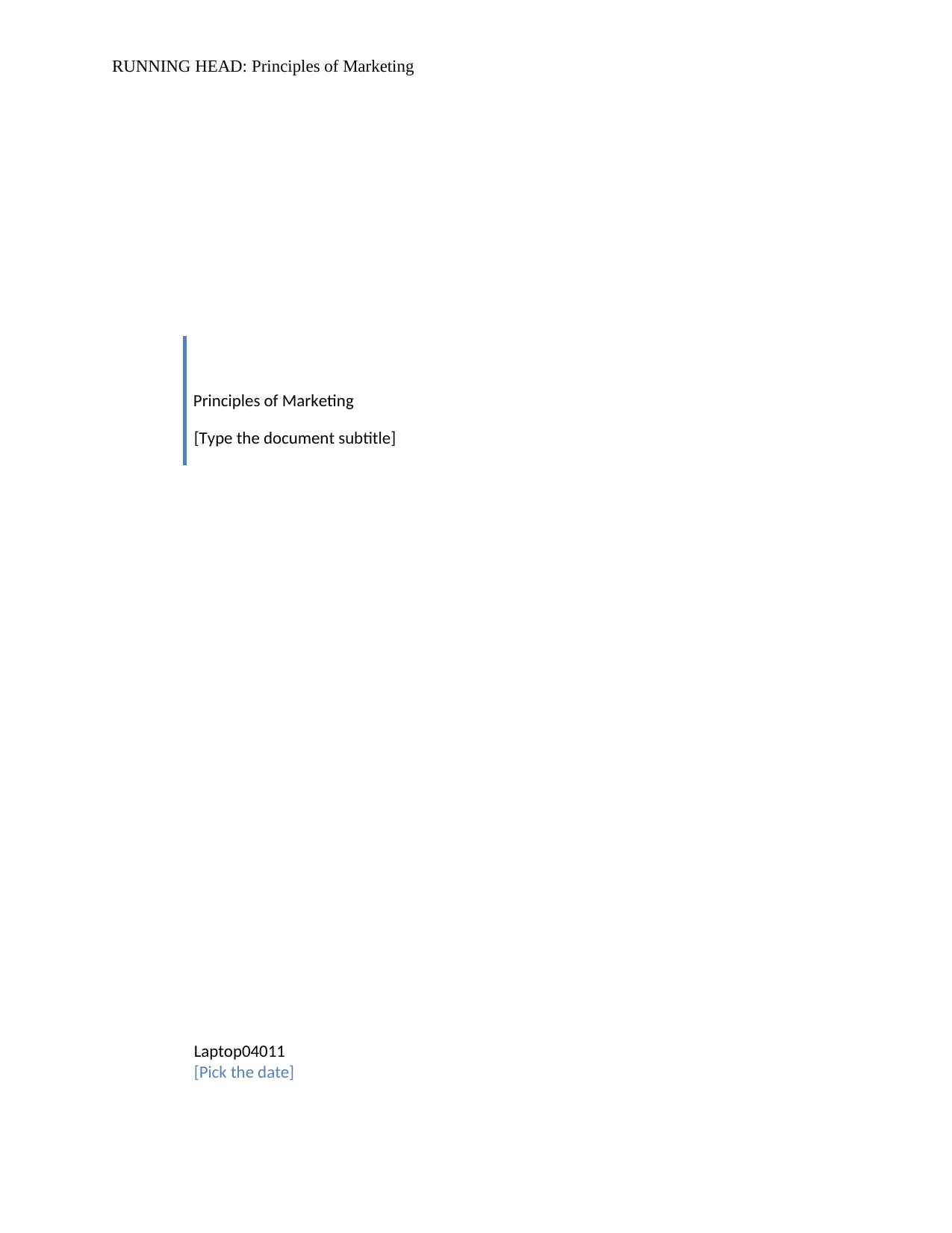
RUNNING HEAD: Principles of Marketing
Principles of Marketing
[Type the document subtitle]
Laptop04011
[Pick the date]
Principles of Marketing
[Type the document subtitle]
Laptop04011
[Pick the date]
Paraphrase This Document
Need a fresh take? Get an instant paraphrase of this document with our AI Paraphraser
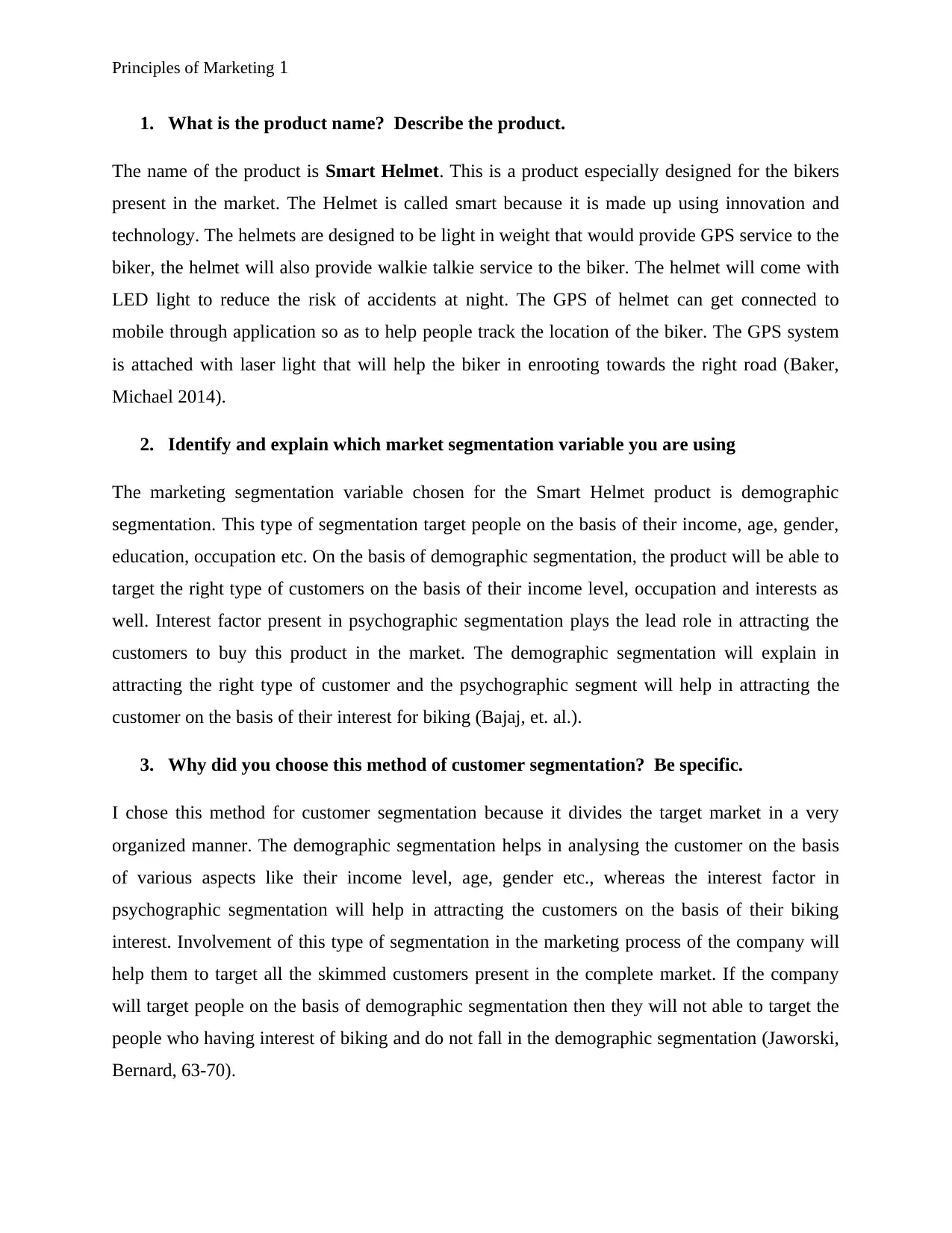
Principles of Marketing 1
1. What is the product name? Describe the product.
The name of the product is Smart Helmet. This is a product especially designed for the bikers
present in the market. The Helmet is called smart because it is made up using innovation and
technology. The helmets are designed to be light in weight that would provide GPS service to the
biker, the helmet will also provide walkie talkie service to the biker. The helmet will come with
LED light to reduce the risk of accidents at night. The GPS of helmet can get connected to
mobile through application so as to help people track the location of the biker. The GPS system
is attached with laser light that will help the biker in enrooting towards the right road (Baker,
Michael 2014).
2. Identify and explain which market segmentation variable you are using
The marketing segmentation variable chosen for the Smart Helmet product is demographic
segmentation. This type of segmentation target people on the basis of their income, age, gender,
education, occupation etc. On the basis of demographic segmentation, the product will be able to
target the right type of customers on the basis of their income level, occupation and interests as
well. Interest factor present in psychographic segmentation plays the lead role in attracting the
customers to buy this product in the market. The demographic segmentation will explain in
attracting the right type of customer and the psychographic segment will help in attracting the
customer on the basis of their interest for biking (Bajaj, et. al.).
3. Why did you choose this method of customer segmentation? Be specific.
I chose this method for customer segmentation because it divides the target market in a very
organized manner. The demographic segmentation helps in analysing the customer on the basis
of various aspects like their income level, age, gender etc., whereas the interest factor in
psychographic segmentation will help in attracting the customers on the basis of their biking
interest. Involvement of this type of segmentation in the marketing process of the company will
help them to target all the skimmed customers present in the complete market. If the company
will target people on the basis of demographic segmentation then they will not able to target the
people who having interest of biking and do not fall in the demographic segmentation (Jaworski,
Bernard, 63-70).
1. What is the product name? Describe the product.
The name of the product is Smart Helmet. This is a product especially designed for the bikers
present in the market. The Helmet is called smart because it is made up using innovation and
technology. The helmets are designed to be light in weight that would provide GPS service to the
biker, the helmet will also provide walkie talkie service to the biker. The helmet will come with
LED light to reduce the risk of accidents at night. The GPS of helmet can get connected to
mobile through application so as to help people track the location of the biker. The GPS system
is attached with laser light that will help the biker in enrooting towards the right road (Baker,
Michael 2014).
2. Identify and explain which market segmentation variable you are using
The marketing segmentation variable chosen for the Smart Helmet product is demographic
segmentation. This type of segmentation target people on the basis of their income, age, gender,
education, occupation etc. On the basis of demographic segmentation, the product will be able to
target the right type of customers on the basis of their income level, occupation and interests as
well. Interest factor present in psychographic segmentation plays the lead role in attracting the
customers to buy this product in the market. The demographic segmentation will explain in
attracting the right type of customer and the psychographic segment will help in attracting the
customer on the basis of their interest for biking (Bajaj, et. al.).
3. Why did you choose this method of customer segmentation? Be specific.
I chose this method for customer segmentation because it divides the target market in a very
organized manner. The demographic segmentation helps in analysing the customer on the basis
of various aspects like their income level, age, gender etc., whereas the interest factor in
psychographic segmentation will help in attracting the customers on the basis of their biking
interest. Involvement of this type of segmentation in the marketing process of the company will
help them to target all the skimmed customers present in the complete market. If the company
will target people on the basis of demographic segmentation then they will not able to target the
people who having interest of biking and do not fall in the demographic segmentation (Jaworski,
Bernard, 63-70).
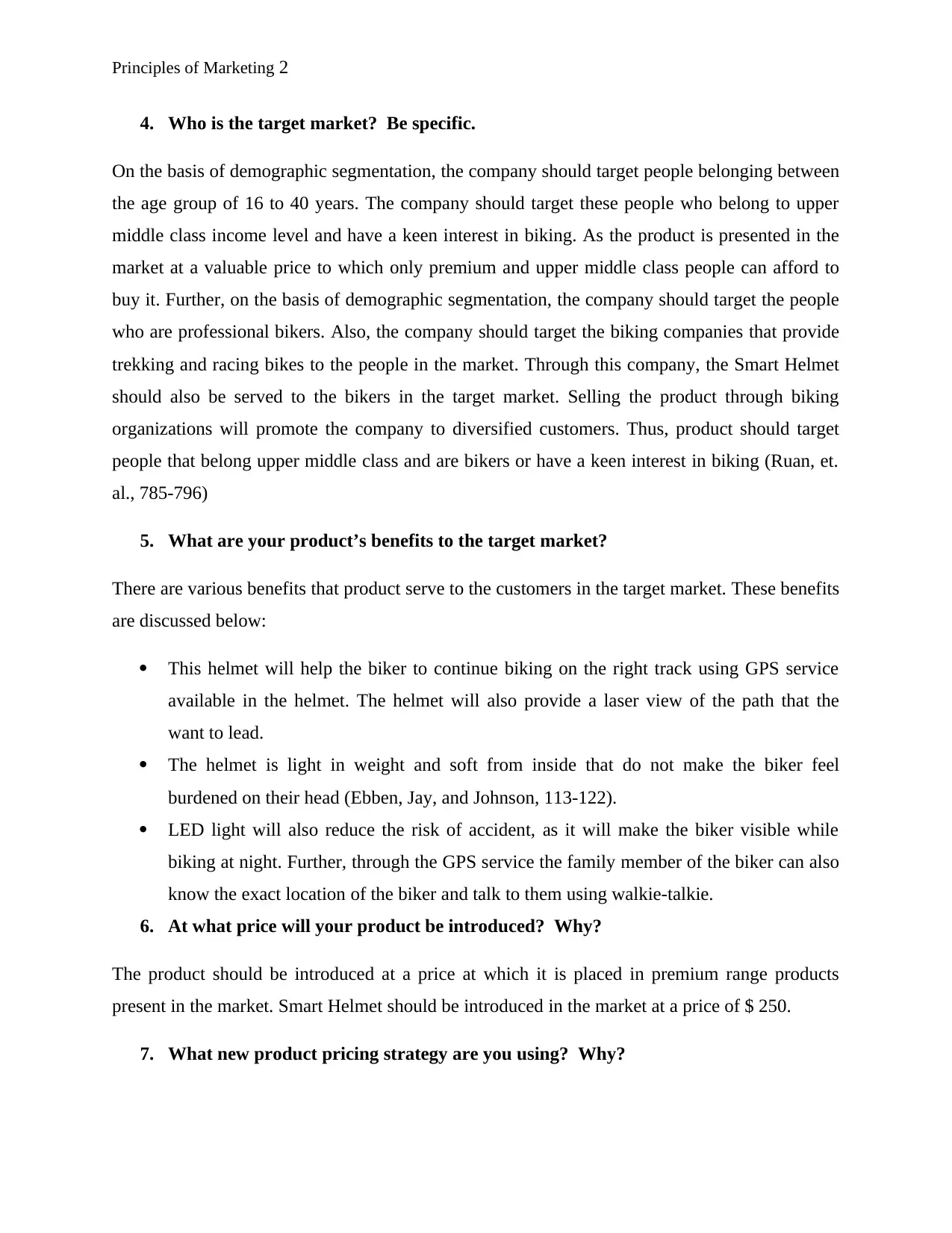
Principles of Marketing 2
4. Who is the target market? Be specific.
On the basis of demographic segmentation, the company should target people belonging between
the age group of 16 to 40 years. The company should target these people who belong to upper
middle class income level and have a keen interest in biking. As the product is presented in the
market at a valuable price to which only premium and upper middle class people can afford to
buy it. Further, on the basis of demographic segmentation, the company should target the people
who are professional bikers. Also, the company should target the biking companies that provide
trekking and racing bikes to the people in the market. Through this company, the Smart Helmet
should also be served to the bikers in the target market. Selling the product through biking
organizations will promote the company to diversified customers. Thus, product should target
people that belong upper middle class and are bikers or have a keen interest in biking (Ruan, et.
al., 785-796)
5. What are your product’s benefits to the target market?
There are various benefits that product serve to the customers in the target market. These benefits
are discussed below:
This helmet will help the biker to continue biking on the right track using GPS service
available in the helmet. The helmet will also provide a laser view of the path that the
want to lead.
The helmet is light in weight and soft from inside that do not make the biker feel
burdened on their head (Ebben, Jay, and Johnson, 113-122).
LED light will also reduce the risk of accident, as it will make the biker visible while
biking at night. Further, through the GPS service the family member of the biker can also
know the exact location of the biker and talk to them using walkie-talkie.
6. At what price will your product be introduced? Why?
The product should be introduced at a price at which it is placed in premium range products
present in the market. Smart Helmet should be introduced in the market at a price of $ 250.
7. What new product pricing strategy are you using? Why?
4. Who is the target market? Be specific.
On the basis of demographic segmentation, the company should target people belonging between
the age group of 16 to 40 years. The company should target these people who belong to upper
middle class income level and have a keen interest in biking. As the product is presented in the
market at a valuable price to which only premium and upper middle class people can afford to
buy it. Further, on the basis of demographic segmentation, the company should target the people
who are professional bikers. Also, the company should target the biking companies that provide
trekking and racing bikes to the people in the market. Through this company, the Smart Helmet
should also be served to the bikers in the target market. Selling the product through biking
organizations will promote the company to diversified customers. Thus, product should target
people that belong upper middle class and are bikers or have a keen interest in biking (Ruan, et.
al., 785-796)
5. What are your product’s benefits to the target market?
There are various benefits that product serve to the customers in the target market. These benefits
are discussed below:
This helmet will help the biker to continue biking on the right track using GPS service
available in the helmet. The helmet will also provide a laser view of the path that the
want to lead.
The helmet is light in weight and soft from inside that do not make the biker feel
burdened on their head (Ebben, Jay, and Johnson, 113-122).
LED light will also reduce the risk of accident, as it will make the biker visible while
biking at night. Further, through the GPS service the family member of the biker can also
know the exact location of the biker and talk to them using walkie-talkie.
6. At what price will your product be introduced? Why?
The product should be introduced at a price at which it is placed in premium range products
present in the market. Smart Helmet should be introduced in the market at a price of $ 250.
7. What new product pricing strategy are you using? Why?
⊘ This is a preview!⊘
Do you want full access?
Subscribe today to unlock all pages.

Trusted by 1+ million students worldwide
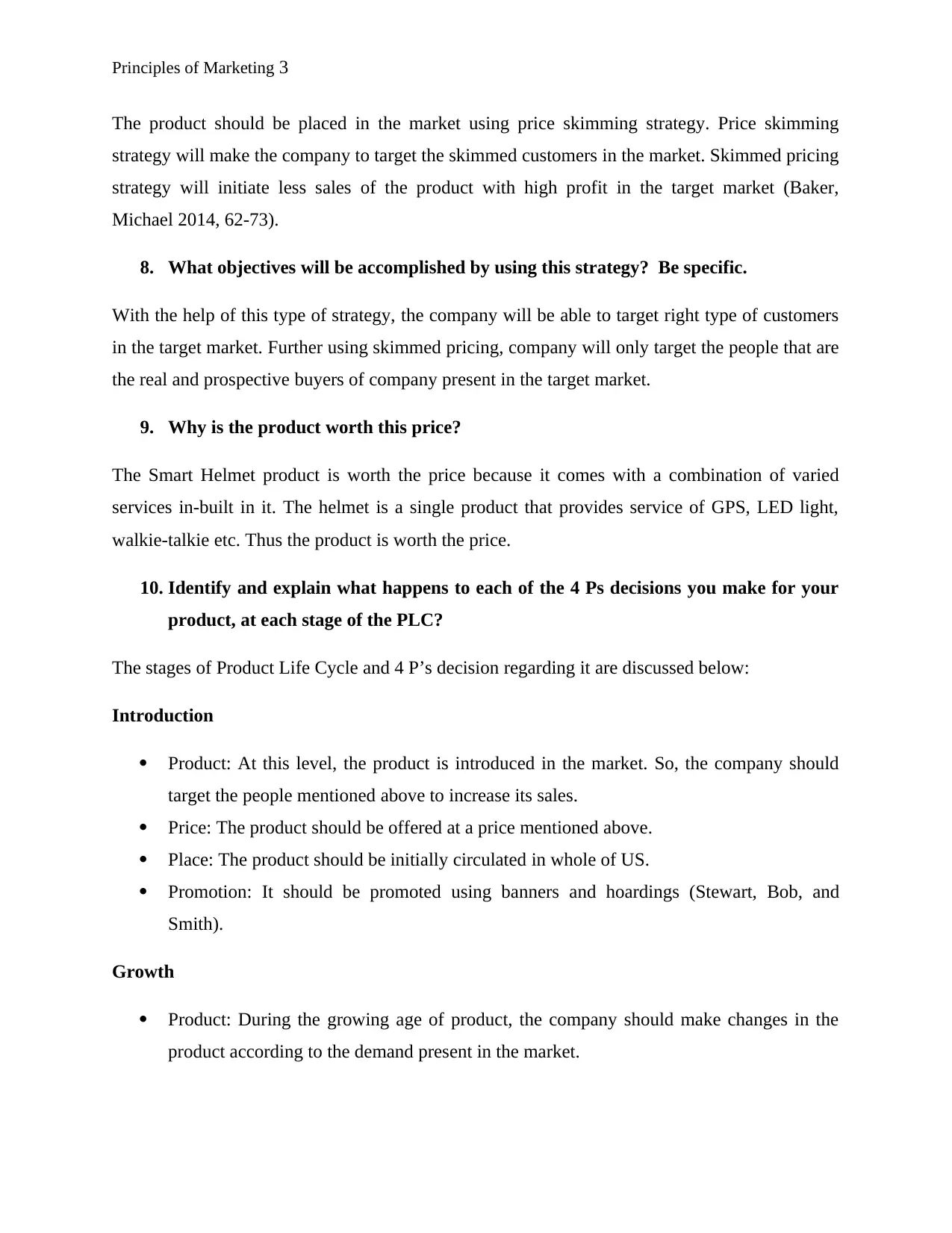
Principles of Marketing 3
The product should be placed in the market using price skimming strategy. Price skimming
strategy will make the company to target the skimmed customers in the market. Skimmed pricing
strategy will initiate less sales of the product with high profit in the target market (Baker,
Michael 2014, 62-73).
8. What objectives will be accomplished by using this strategy? Be specific.
With the help of this type of strategy, the company will be able to target right type of customers
in the target market. Further using skimmed pricing, company will only target the people that are
the real and prospective buyers of company present in the target market.
9. Why is the product worth this price?
The Smart Helmet product is worth the price because it comes with a combination of varied
services in-built in it. The helmet is a single product that provides service of GPS, LED light,
walkie-talkie etc. Thus the product is worth the price.
10. Identify and explain what happens to each of the 4 Ps decisions you make for your
product, at each stage of the PLC?
The stages of Product Life Cycle and 4 P’s decision regarding it are discussed below:
Introduction
Product: At this level, the product is introduced in the market. So, the company should
target the people mentioned above to increase its sales.
Price: The product should be offered at a price mentioned above.
Place: The product should be initially circulated in whole of US.
Promotion: It should be promoted using banners and hoardings (Stewart, Bob, and
Smith).
Growth
Product: During the growing age of product, the company should make changes in the
product according to the demand present in the market.
The product should be placed in the market using price skimming strategy. Price skimming
strategy will make the company to target the skimmed customers in the market. Skimmed pricing
strategy will initiate less sales of the product with high profit in the target market (Baker,
Michael 2014, 62-73).
8. What objectives will be accomplished by using this strategy? Be specific.
With the help of this type of strategy, the company will be able to target right type of customers
in the target market. Further using skimmed pricing, company will only target the people that are
the real and prospective buyers of company present in the target market.
9. Why is the product worth this price?
The Smart Helmet product is worth the price because it comes with a combination of varied
services in-built in it. The helmet is a single product that provides service of GPS, LED light,
walkie-talkie etc. Thus the product is worth the price.
10. Identify and explain what happens to each of the 4 Ps decisions you make for your
product, at each stage of the PLC?
The stages of Product Life Cycle and 4 P’s decision regarding it are discussed below:
Introduction
Product: At this level, the product is introduced in the market. So, the company should
target the people mentioned above to increase its sales.
Price: The product should be offered at a price mentioned above.
Place: The product should be initially circulated in whole of US.
Promotion: It should be promoted using banners and hoardings (Stewart, Bob, and
Smith).
Growth
Product: During the growing age of product, the company should make changes in the
product according to the demand present in the market.
Paraphrase This Document
Need a fresh take? Get an instant paraphrase of this document with our AI Paraphraser
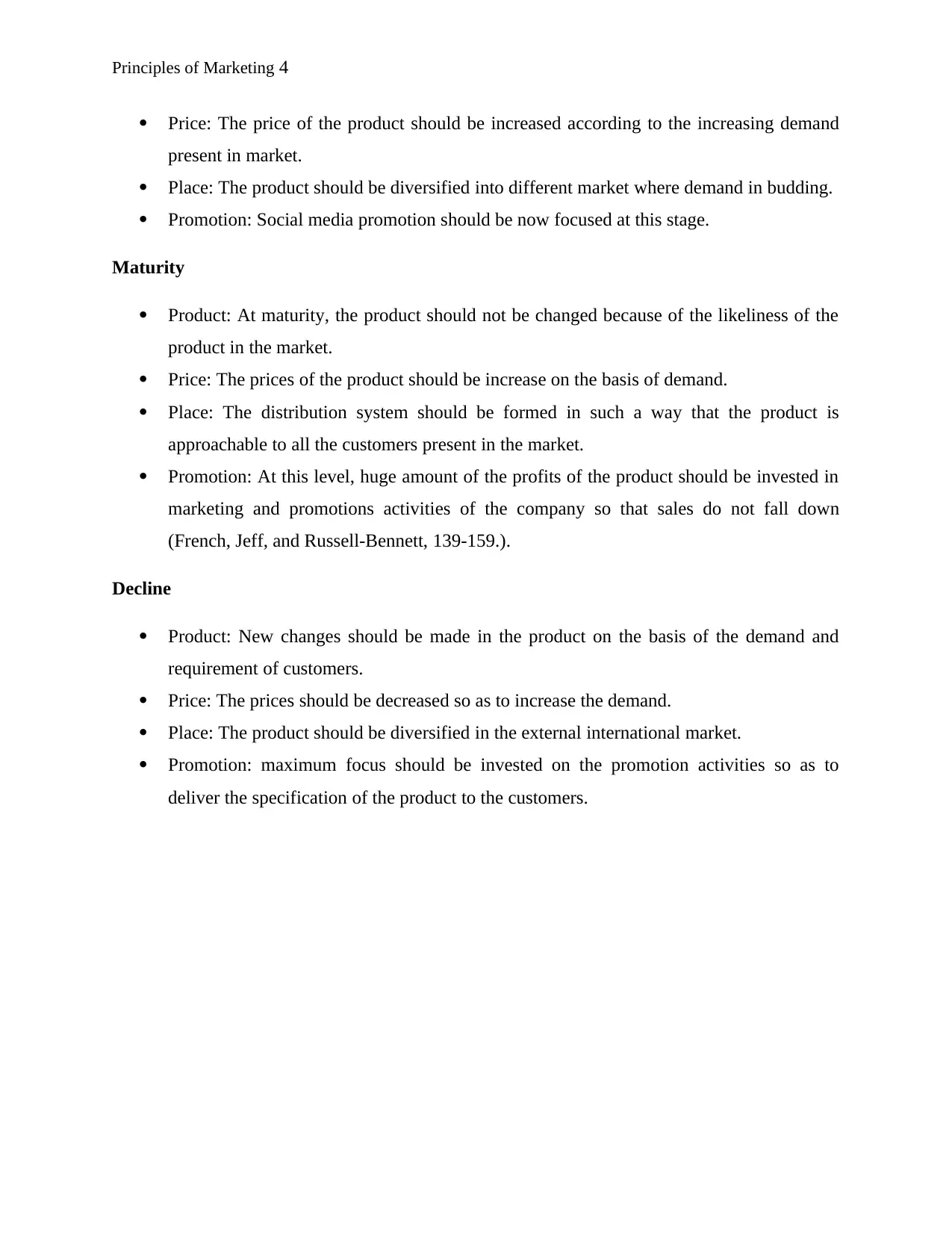
Principles of Marketing 4
Price: The price of the product should be increased according to the increasing demand
present in market.
Place: The product should be diversified into different market where demand in budding.
Promotion: Social media promotion should be now focused at this stage.
Maturity
Product: At maturity, the product should not be changed because of the likeliness of the
product in the market.
Price: The prices of the product should be increase on the basis of demand.
Place: The distribution system should be formed in such a way that the product is
approachable to all the customers present in the market.
Promotion: At this level, huge amount of the profits of the product should be invested in
marketing and promotions activities of the company so that sales do not fall down
(French, Jeff, and Russell-Bennett, 139-159.).
Decline
Product: New changes should be made in the product on the basis of the demand and
requirement of customers.
Price: The prices should be decreased so as to increase the demand.
Place: The product should be diversified in the external international market.
Promotion: maximum focus should be invested on the promotion activities so as to
deliver the specification of the product to the customers.
Price: The price of the product should be increased according to the increasing demand
present in market.
Place: The product should be diversified into different market where demand in budding.
Promotion: Social media promotion should be now focused at this stage.
Maturity
Product: At maturity, the product should not be changed because of the likeliness of the
product in the market.
Price: The prices of the product should be increase on the basis of demand.
Place: The distribution system should be formed in such a way that the product is
approachable to all the customers present in the market.
Promotion: At this level, huge amount of the profits of the product should be invested in
marketing and promotions activities of the company so that sales do not fall down
(French, Jeff, and Russell-Bennett, 139-159.).
Decline
Product: New changes should be made in the product on the basis of the demand and
requirement of customers.
Price: The prices should be decreased so as to increase the demand.
Place: The product should be diversified in the external international market.
Promotion: maximum focus should be invested on the promotion activities so as to
deliver the specification of the product to the customers.
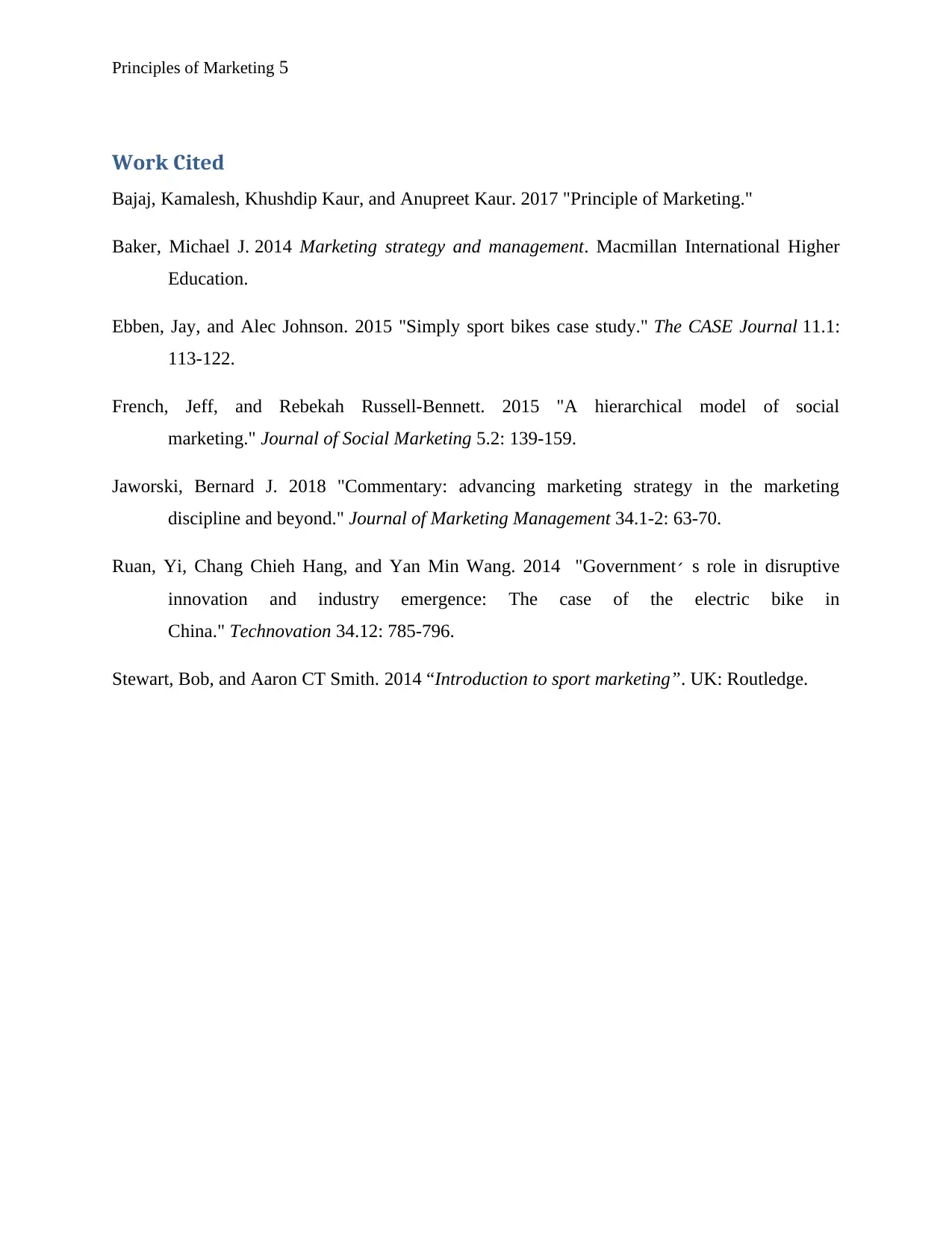
Principles of Marketing 5
Work Cited
Bajaj, Kamalesh, Khushdip Kaur, and Anupreet Kaur. 2017 "Principle of Marketing."
Baker, Michael J. 2014 Marketing strategy and management. Macmillan International Higher
Education.
Ebben, Jay, and Alec Johnson. 2015 "Simply sport bikes case study." The CASE Journal 11.1:
113-122.
French, Jeff, and Rebekah Russell-Bennett. 2015 "A hierarchical model of social
marketing." Journal of Social Marketing 5.2: 139-159.
Jaworski, Bernard J. 2018 "Commentary: advancing marketing strategy in the marketing
discipline and beyond." Journal of Marketing Management 34.1-2: 63-70.
Ruan, Yi, Chang Chieh Hang, and Yan Min Wang. 2014 "Government׳ s role in disruptive
innovation and industry emergence: The case of the electric bike in
China." Technovation 34.12: 785-796.
Stewart, Bob, and Aaron CT Smith. 2014 “Introduction to sport marketing”. UK: Routledge.
Work Cited
Bajaj, Kamalesh, Khushdip Kaur, and Anupreet Kaur. 2017 "Principle of Marketing."
Baker, Michael J. 2014 Marketing strategy and management. Macmillan International Higher
Education.
Ebben, Jay, and Alec Johnson. 2015 "Simply sport bikes case study." The CASE Journal 11.1:
113-122.
French, Jeff, and Rebekah Russell-Bennett. 2015 "A hierarchical model of social
marketing." Journal of Social Marketing 5.2: 139-159.
Jaworski, Bernard J. 2018 "Commentary: advancing marketing strategy in the marketing
discipline and beyond." Journal of Marketing Management 34.1-2: 63-70.
Ruan, Yi, Chang Chieh Hang, and Yan Min Wang. 2014 "Government׳ s role in disruptive
innovation and industry emergence: The case of the electric bike in
China." Technovation 34.12: 785-796.
Stewart, Bob, and Aaron CT Smith. 2014 “Introduction to sport marketing”. UK: Routledge.
⊘ This is a preview!⊘
Do you want full access?
Subscribe today to unlock all pages.

Trusted by 1+ million students worldwide
1 out of 6
Related Documents
Your All-in-One AI-Powered Toolkit for Academic Success.
+13062052269
info@desklib.com
Available 24*7 on WhatsApp / Email
![[object Object]](/_next/static/media/star-bottom.7253800d.svg)
Unlock your academic potential
Copyright © 2020–2025 A2Z Services. All Rights Reserved. Developed and managed by ZUCOL.




